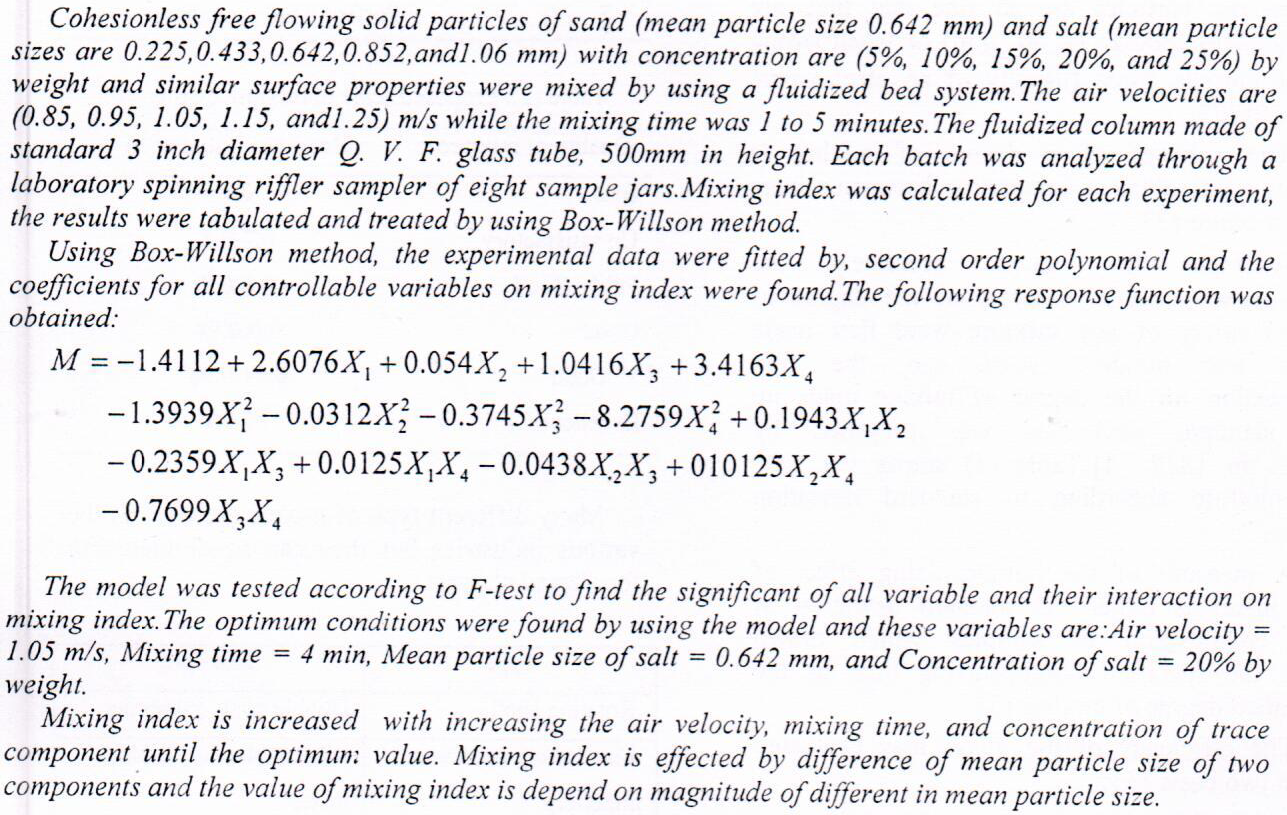
This study suggests using the recycled plastic waste to prepare the polymer matrix composite (PMCs) to use in different applications. Composite materials were prepared by mixing the polyester resin (UP) with plastic waste, two types of plastic waste were used in this work included polyethylene-terephthalate (PET) and Polyvinyl chloride (PVC) with varies weight fractions (0, 5, 10, 15, 20 and 25 %) added as a filler in flakes form. Charpy impact test was performed on the prepared samples to calculate the values of impact strength (I.S). Flexural and hardness tests were carried out to calculate the values of flexural strength and hardness. Acoustic insulation and optical microscope tests were carried out. In general, it is found that UP/PV
... Show More (2)
(2)
A problem of solid waste became in the present day common global problem among all countries, whether developing or developed countries, and can say that no country in the world today is immuning from this dilemma which must find appropriate solutions. The problem has reached a stage that can not ignore or delay, but has became a daily problem occupies the minds of ecologists, economists and politicians took occupies center front in the lists of priorities for the countries in terms of finding solutions to the rapid scientific and radical them. and that transport costs constitute an important component of total costs borne by the municipal districts in the process of disposal of solid waste, so any improvement in the
... Show MoreSilybum marianum, from which silymarin (SM) is extracted, is a medicinal herb. In the Biopharmaceutics Classification System, it is of the class II type, meaning it is almost completely insoluble in water. It has a number of therapeutic properties, including anti-inflammatory as well as properties that promote wound healing.
This research target is to promote the dissolution and solubility of SM by employing a technique called solid dispersion and then incorporating the formula of solid dispersion into a topical gel that can be used for wound healing.
Solid dispersion is a technique used to enhance solubility and dissolve pharmaceuticals that are not water-soluble. This method is widely used because of its low cos
... Show More (12)
(12)
 (5)
(5)
This study aimed to knowledge of the effects of the Traditional ore upon the structure of sculpture form, as well as to knowledge of new materials that was used for the contemporary sculpture. This study included four chapter: first chapter was specialized for methodical frame. such as problem of research. that it was abstracted by question about the reason that lead the sculptor to search from new raw to carry out his sculpture works? As well as the important of research and its limits was that define between year 1950 up to 2000. The second chapter included the theoretical field and previous studies, that formed from three researches, such as the fist about the materials, as it was considered master element at the sculpture formal. the
... Show MoreSoils that cause effective damages to engineer structures (such as pavement and foundation) are called problematic or difficult soils (include collapsible soil, expansive soil, etc.). These damages occur due to poor or unfavorited engineering properties, such as low shear strength, high compressibility, high volume changes, etc. In the case of expansive soil, the problem of the shrink-swell phenomenon, when the soil reacts with water, is more pronounced. To overcome such problems, soils can be treated or stabilized with many stabilization ways (mechanical, chemical, etc.). Such ways can amend the unfavorited soil properties. In this review, the pozzolanic materials have been selected to be presented and discussed as chem
... Show More (16)
(16)
Solid dispersion (SD) formulation has attracted much attention due to its potential in enhancing dissolution performances of poorly soluble active pharmaceutical ingredients (API). Recently, a review on dissolution performances of SDs classifies the improvement into 3 categories, where 82 % of the studies showed improved bioavailability, 8 % showed reduced bioavailability and 10 % revealed similar bioavailability as compared to pure APIs. This indicates the inconsistent degrees of dissolution improvement of poorly soluble APIs in SD. Although a few factors related to the choice of carriers have been suggested to contribute to the dissolution improvement, however, the underlying factor determining the discrepancy in the degree of dissolution
... Show MoreObjective:Fluorid-containing dental alginate impression materials can exert a considerable reduction in
enamel solubility. The objective was to evaluate the effect of fluoride addition on the setting time and
compressive strength of alginate impression materials.
Methodology: 60 samples were constructed from alginate impression material (30 samples for setting
time test and 30 samples for compressive strength test).Specimens of each test divided into three
subgroup. Group A: 10 specimens of alginate were mixed with distilled water [control], Group B: 10
specimens of alginate were mixed with100-ppm fluoride and Group C:10 specimens of alginate were
mixed with 2%Naf.
Results: the result of setting time test showed t
The current research is concerned with methods of formation and their effect on the sintering process of ceramic materials. The research is divided into a number of chapters. The first chapter addressed the research structure (the research problem, importance, objective, limits, and it also defined the terms used in the research). The second chapter addressed the theoretical framework, where the theoretical framework has been divided into three sections. The first section dealt with methods of formation of ceramic materials including: Plasticizing method 2- semi-dry pressing method 3- dry pressing method 4- extrusion method 5- casting method.
The researcher found that there is a clear difference between the methods through her formati
